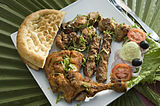food.wikisort.org - Dish
Pasanda (Urdu: پسندہ, Hindi: पसन्दा), also called Parche (Urdu: پارچے, Hindi: पारचे), is a popular meat Shahi Mughalayi dish from the Indian subcontinent, notably North India, Rampur, Hyderabadi and Pakistani, derived from a meal served in the court of the Mughal emperors. The word is a variation on the Hindi-Urdu word "pasande" meaning "favourite", which refers to the prime cuts of meat traditionally used in the dish.
This article needs additional citations for verification. (December 2018) |
 Pasanda curry | |
| Alternative names | Parche |
|---|---|
| Course | Main course |
| Place of origin | Mughal India |
| Region or state | Indian subcontinent |
| Associated national cuisine | India, Bangladesh, Pakistan |
| Main ingredients | Meat (lamb, goat, beef) |
| Variations | Poultry or seafood |
Ingredients and preparation
Pasanda was originally made with leg of lamb or goat flattened into strips, marinated, and fried in a dish with seasoning. In Pakistan, Pasanday is usually made from Pot Roast Beef Fillets flattened into strips.[1] In the present day, pasanda is also made with chicken and king prawns; in each case, the process and ingredients remain generally the same.
After the meat is cut and flattened, it is placed in a marinade consisting of yogurt, chili powder, and numerous spices and seasonings, which commonly include cumin, peppercorn, cardamom, and garlic. After a few hours of marination, the meat is placed in a saucepan with the other ingredients that make up the "pasanda" itself—onions, coriander, chillies, and sometimes cinnamon or black pepper—then fried for 30 minutes to an hour. The dish may be garnished with tomatoes or almonds (in which case it is known as badaam pasanda). It is often served with white rice or naan on the side.
History
Though its invention is ascribed to the Mughal court, the recipe may have been a development of pre-existing cooking techniques, with a similar method of preparation being described in the Manasollasa of the 12th century AD.[2]
Variants
Although pasanda is usually served as a meat dish, it may also be prepared in kebab form. Reflecting the dish's flavour and its connection with the almond, pasanda also refers to a mild curry sauce made with cream, coconut milk or yoghurt and almonds.
See also
- List of lamb dishes
- Pakistani meat dishes
 Food portal
Food portal Pakistan portal
Pakistan portal India portal
India portal
References
- Beef Fillets (Pasanday) Recipe
- "Biryani: Ek Khoj". www.hindustantimes.com. 2 February 2019. Retrieved 11 February 2019.
На других языках
- [en] Pasanda
[es] Pasanda
El pasanda es un curry de carne muy popular en el norte de la India y Pakistán, que tiene por orígenes los platos servidos en la Corte de los Emperadores Moghul. La denominación pasanda es una variación de la palabra hindi "pasande" o lo que traducido es "el favorito" y que se refiere al primer corte realizado en la carne y que de forma tradicional se emplea en su elaboración. La palabra tiene también relación etimológica con el urdu "Pansand" que significa "placentero".[ru] Пасанда
Пасанда — популярное мясное блюдо родом из индийского субконтинента, в частности, из Северной Индии, штата Хайдарабади, а также Пакистана. Произошло от блюда, подаваемого при дворе императоров Моголов, является характерным для могольской кухни. Название блюда связано со словом «пасанде», что на языке урду означает «фаворит», «лучший», «любимец». По одним данным, это относится к сорту мяса, традиционно используемого для пасанды; по другим — к самому блюду. Может обозначаться как карри[1].Другой контент может иметь иную лицензию. Перед использованием материалов сайта WikiSort.org внимательно изучите правила лицензирования конкретных элементов наполнения сайта.
WikiSort.org - проект по пересортировке и дополнению контента Википедии



